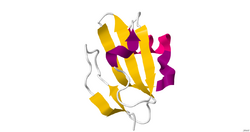Biology:CD59 antigen
| u-PAR/Ly-6 domain | |||||||||||
|---|---|---|---|---|---|---|---|---|---|---|---|
 | |||||||||||
| Identifiers | |||||||||||
| Symbol | UPAR_LY6 | ||||||||||
| Pfam | PF00021 | ||||||||||
| InterPro | IPR001526 | ||||||||||
| PROSITE | PDOC00756 | ||||||||||
| SCOP2 | 1erg / SCOPe / SUPFAM | ||||||||||
| CDD | cd00117 | ||||||||||
| |||||||||||
CD59 antigen (also called 1F-5Ag, H19, HRF20, MACIF, MIRL, P-18 or protectin) inhibits formation of membrane attack complex (MAC), thus protecting cells from complement-mediated lysis. It has a signaling role, as a GPI anchored molecule, in T cell activation and appears to have some role in cell adhesion through CD2 (controversial). CD59 associates with C9, inhibiting incorporation into C5b-8 preventing terminal steps in polymerization of the (MAC) in plasma membranes. Genetic defects in GPI-anchor attachment that cause a reduction or loss of both CD59 and CD55 on erythrocytes produce the symptoms of the disease paroxysmal nocturnal hemoglobinuria (PNH).
A variety of GPI-linked cell-surface glycoproteins are composed of one or more copies of a conserved domain of about 100 amino-acid residues.[2][3] Among these proteins, U-PAR contains three tandem copies of the domain, while all the others are made up of a single domain.
As shown in the following schematic, this conserved domain contains 10 cysteine residues involved in five disulfide bonds - in U-PAR, the first copy of the domain lacks the fourth disulfide bond.
+------+ +------------------------+ +---+
| | | | | |
| | | |
+---------------------+ +--------------+
'C': conserved cysteine involved in a disulfide bond.
CD molecules are leucocyte antigens on cell surfaces. CD antigens nomenclature is updated at Protein Reviews On The Web (http://mpr.nci.nih.gov/prow/).
Subfamilies
- Urokinase plasminogen activator surface receptor InterPro: IPR003631
- Cell-surface glycoprotein Ly-6/CD59 InterPro: IPR003632
Human proteins containing this domain
ARS; CD177; CD59; LY6D; LY6E; LY6H; LYNX1; LYPD2; LYPD3; LYPD4; LYPD5; LYPD6; PLAUR; PSCA; SLURP2; SLURP1; SPACA4; TEX101;
References
- ↑ PDB: 2J8B; "High-resolution structures of bacterially expressed soluble human CD59". Acta Crystallographica Section F 63 (Pt 8): 648–52. August 2007. doi:10.1107/S1744309107033477. PMID 17671359.
- ↑ "The ligand-binding domain of the cell surface receptor for urokinase-type plasminogen activator". J. Biol. Chem. 266 (12): 7842–7847. 1991. PMID 1850423.
- ↑ "Localization of the disulfide bonds in the NH2-terminal domain of the cellular receptor for human urokinase-type plasminogen activator. A domain structure belonging to a novel superfamily of glycolipid-anchored membrane proteins". J. Biol. Chem. 268 (23): 17539–17546. 1993. PMID 8394346.

